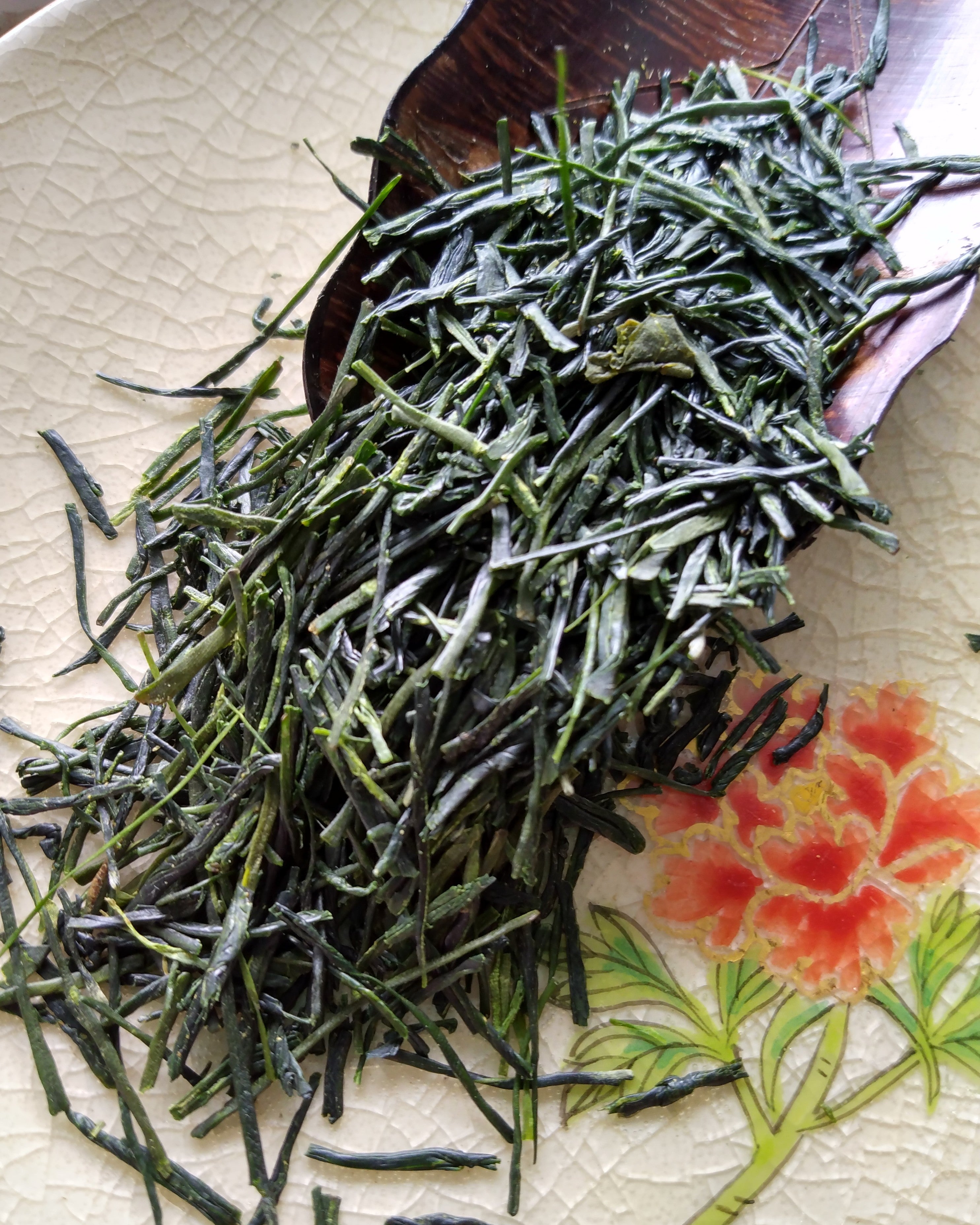Varieties
Japanese Tea Varieties
Below is a brief glossary to help you navigate your way through the world of Japanese tea. Visit our Tea Shop pages for detailed information on specific teas. Read on for more information about the world of Japanese Green Tea.
Bancha: later harvests and leaves further down the stem than those used for sencha are used to produce this tea. It has a bold taste and is served often in lower to mid-range restaturants. It can also be roasted to produce houjicha, or mixed with roasted brown rice to produce lower grades of genmaicha. In addition, there is Kyou-Bancha, a higher quality bancha exclusively from Kyoto.
Fukamushicha: “Deep-Steamed Tea.” This tea undergoes initial steaming 2-3 times longer than normal. This produces a deep green leaf, flavor, and aroma. However, this additional heat also reduces the level of caffeine slightly. The color and flavor may make it seem like a “stronger” tea, when in fact it just has a unique character.
Genmaicha: sencha or bancha can be mixed with roasted brown rice to produce this fragrant and slightly nutty tasting tea. Some say the aroma and taste are somewhat reminiscent of popcorn. And due to the presence of some of the brown rice kernels that have “popped,” it is sometimes referred to in the West as “popcorn tea.”
Gyokuro: special cultivars and the shade-growing techniques mentioned below are used to create the high end of Japanese leaf teas. Shade-growing 2-3 weeks prior to harvest reduces the tannin content (thereby reducing astringency), and increases the retention of theanine and flavor-producing glutamic acid. The end result is a delicate tea that is also rich in flavor. Gyokuro is also higher in caffeine than sencha.
Houjicha: roasted bancha leaves make this tea that is brown in color and liquor, but still a “green” tea. It has a wonderfully savory fragrance and flavor. Roasting also greatly reduces the caffeine and tannin content making it a low-caffeine alternative with a mellow, toasted flavor.
Kabusecha: this terms refers to “covered tea” that is shade-grown shortly before harvest. Gyokuro and Tencha, the base tea for Matcha, are examples of shade-grown teas, but the term can also be applied to sencha grown by this method.
Kamairicha: “Pan-fired Tea.” This tea which uses the pan-firing technique rather than steaming is part of the tea cultures of Saga, Miyazaki, Nagasaki, and Kumamoto Prefectures in Kyushu. It has a rich and slightly roasted flavor.
Karigane: a variety of stem tea (see kukicha below) made exclusively from the stems of Gyokuro tea. Uji, in Kyoto, is a notable producer of Karigane.
Konacha: literally “powder tea,” konacha is sencha that is coarsely ground into powder. This is the traditional tea served in sushi bars in Japan, where it is ordered as “agari” (to get up) and signals the end of the meal. Konacha has recently gained popularity among the elderly for the convenience factor and as a way to consume the whole tea leaf .
Kukicha: this tea is produced by using the stems, instead of the leaves. Kukicha from Sencha has a rich yellow liquor, lower caffeine content, and a mild grassy flavor. More delicate and flavorful is kukicha made from the stems of Gyokuro tea. This tea is known as Karigane. Kukicha may also be made from the stems of Houjicha, and exhibits the toasted, slightly smoky quality of this base tea.
Matcha: Stone-ground powdered tea created from Tencha leaves. It is the tea used in the Japanese tea ceremony, but highly encouraged for everyday use as well. The powder is whisked in a small amount of hot water, instead of being infused from the leaves. The whole leaf form makes it the Japanese tea highest in nutritional content. The growing method makes it a rich tea, with a particular form of amami, “sweetness,” in the taste.
Mecha: This tea is made from the buds of sencha or gyokuro, and produces a light yellow refreshing brew.
Sencha: the term refers to the top-harvested bud and two leaves of the tea plant. Quality sencha contains a gentle sweetness and at the same time a mild astringency. It is rich in flavor and antioxidants and is the most popular tea in Japan, comprising over 70% of the market. First-flush sencha is shincha, but the tea bush can flush two or three more times in a season, creating ni-ban (2nd) and san-ban (3rd), etc., Sencha.
Shincha: refers to “new tea” and is anticipated in Japan as much as the Beaujoulais Nouveau in France. The first flush of the year can occur as early as late February-early March in Okinawa, but is generally thought of in Japan as beginning on the 88th day after the early February start of spring on the traditional Japanese calendar. For central Japan, this is usually in May. Shincha is thought to have more flavor and higher nutritional content than later harvested tea, creating an extremely high market demand for this product.
Sobacha: this “Buckwheat Tea” is technically not a tea at all since it does not come from Camellia Sinensis. But roasted buckwheat kernels do create a rich golden tea-tasting liquor and warm, nutty flavor without the astringency or caffeine of tea. For those seeking a completely non-caffeine Japanese “tea” product, this is a popular choice.
Tamaryokucha: literally “ball green tea,” tamaryokucha uses a special rolling technique to create a finished tea more curled into balls than rolled into the classic Japanese “needle” shape. It is also often a type of “kama-iri” or “pan-fired” tea. Well-known production areas of tamaryokucha include Miyazaki and Saga Prefectures in Kyushu.
